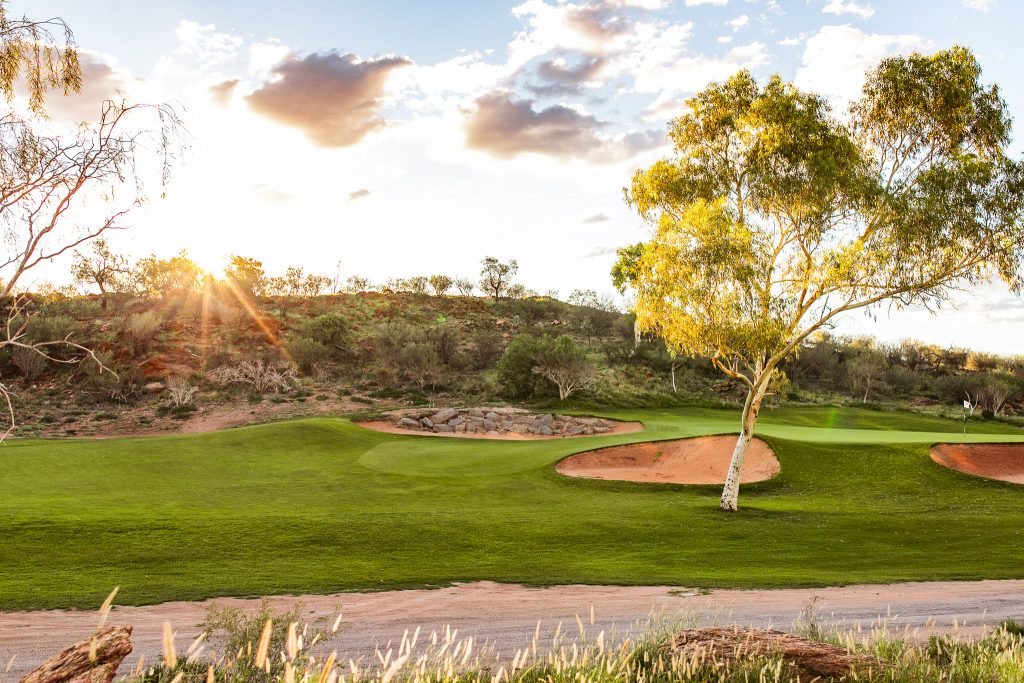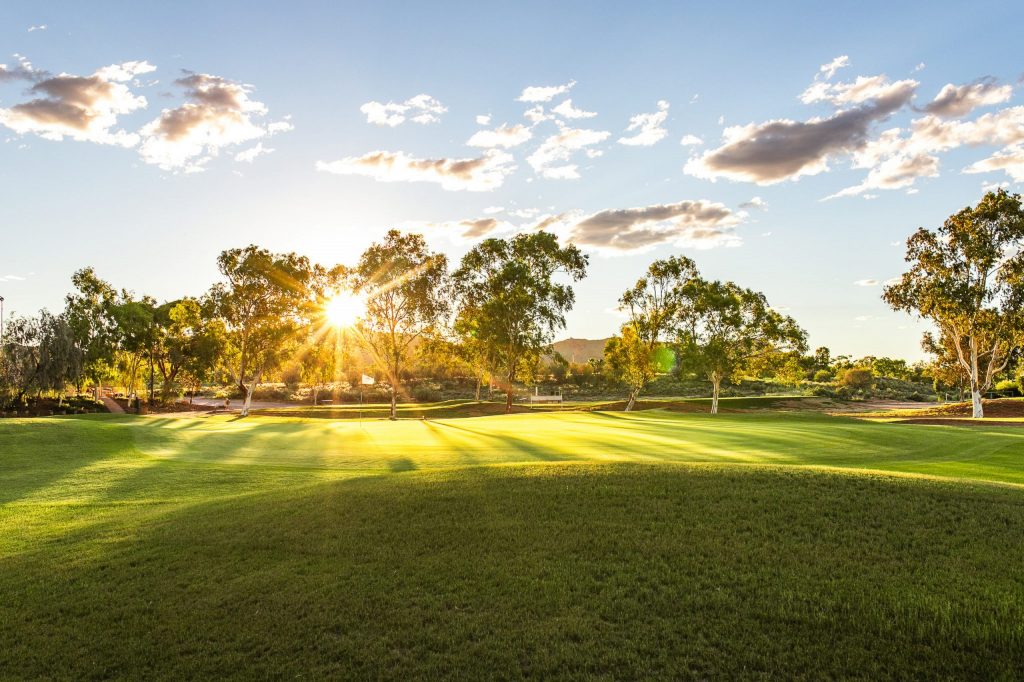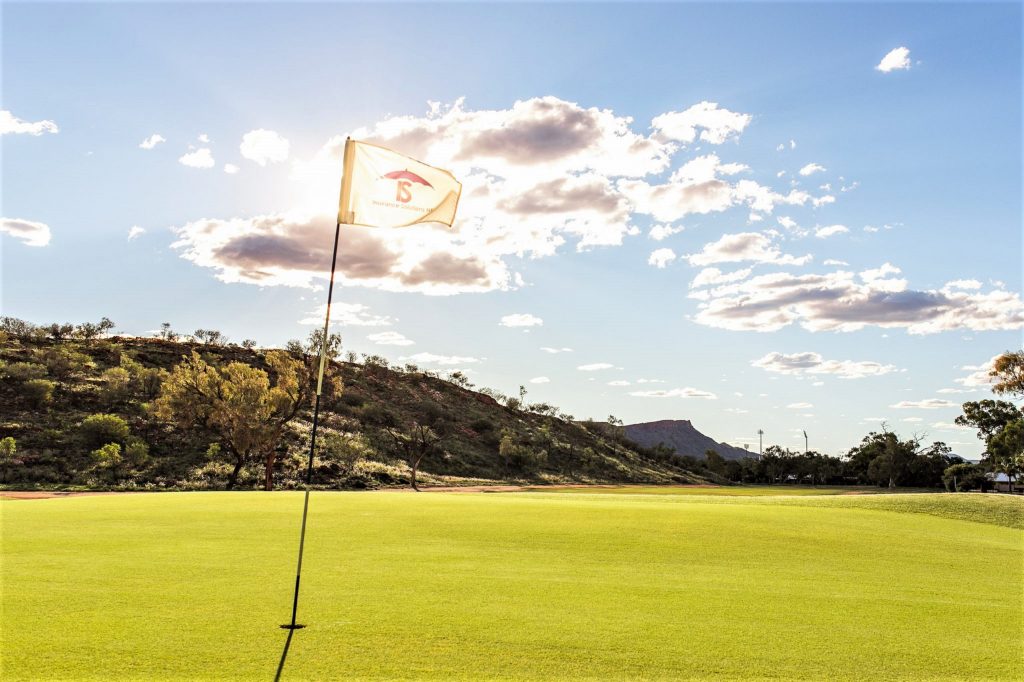
AT sunset the Alice Springs Golf Club is bathed in a ribbon of golden colour.
Stripes of drab brown and muted green become awash of crimson, orange, purple and golf as the days comes to an end on one of the world’s top-10 desert golf courses.
As the sun descends, the ancient MacDonnell Ranges light up like a brilliant amber stone – a moment treasured by golfers who visit the iconic Northern Territory course.
Situated in the heart of the desert on the outskirts of Alice Springs, the Peter Thomson and Mike Wolveridge-designed golf course has earned a reputation as a golf resort with a difference.
The par-72 championship layout was opened in 1985 by Greg Norman and American Johnny Miller.
Since then it has matured into a world-class course with neatly woven fairways and huge manicured greens.
Still, for all its beauty it is a course vastly different to other luxury resorts around Australia.
Beyond the narrow green strips of manicured fairways lies a fringe of sandy, rocky rough – a constant reminder of the harsh reality of the surrounding desert.
While the fairways are narrow, some just 20m wide, the course is open which allows golfers to find their ball in the rough – albeit among dirt and rocks.
And that’s where the rock wedge comes into play.
“It becomes an adventurous place to play once you are off the fairways,” the club’s general manager Jai Pumphrey said.
“Most golfers carry a rock wedge (an old 5- or 7-iron) so they don’t damage their other clubs.”
“The second hole is iconic for this as there is a caterpillar-shaped rock formation down the right side of hole.
“It’s a hole where the rock rescue club comes into play.
“If you end up in the rocks, just advance the ball 100m back to the fairway and cop it.”
“With a landing zone of around 45m left to right from houses to rocks, a decision must be made on the tee block if you want to reach this green with your second shot.
“It is a two-tiered green with the top tier completely guarded by a large bunker.
“If the pin is up top this is one of the hardest and most rewarding two shots (three for the ladies) on the course if you are lucky enough to end pin high.”
So, accuracy is critical – even the big hitters reduce their power to ensure a safe drive rather than braving the rough.
Wayward hitters are forced to contend with the natural landscape plus the menagerie of desert wildlife including kangaroos, dingoes and lizards that often emerge from the rocky outcrop.
The layout is typical of its designers featuring nine par-4s, four par-5s and four challenging par-3s.
The front nine is built around a rocky outcrop while the back nine is more of a links-style course featuring a lake.
The eighth hole is considered the course’s signature hole.
“It dog-legs right, is not overly long, around 360m, and is played from an elevated tee block among some arid land,” Pumphrey said.
“The fairway bunkers can come into play and the fairway is on an angle so you need to land on top otherwise the ball will run away to the right.
“The shot to the green is tight with a couple of big white gum trees blocking your approach from the left and there are bunkers around the green.”
Pumphrey said Alice Springs’ dry air often led to greater ball carry.
“But the dry conditions also make some greens difficult to catch when approaching from greater than 150m out,” he said.
Undoubtedly, the best time to play is at sunrise and sunset so the MacDonnell Ranges’ changing colours can be enjoyed.
Alice Springs boasts 2000 social members and over 400 playing members.
The club also has a bowling green which is fantastic for functions and used 5 times a week for social and competitive play. The driving range is also a popular meeting place open for night use throughout the week in the warm weather.
The comfortable clubhouse is open six days a week and is popular with locals and visitors alike.
“We are one of the premier function locations in Alice Springs,” Pumphrey said.
“We run 10-15 functions every week in November and December and having fantastic views from the clubhouse is a bonus.
“Those events help our cash flow which means we are not fully reliant on golf and bowls.”
“We are trying to reach out in other directions to make sure we get different people coming though our door on a regular basis.”
Head professional Stephen Tieck runs a slick operation from the pro shop and offers lessons and club-fitting sessions.
The shop also has clubs for sale, cart hire and range balls. Their motto: “If we don’t have it, we’ll get it.”
FACT FILE
Getting there: It’s a 15-minute drive from the Alice Springs Airport. The golf course resides behind the main resorts of Alice Springs on Barret Drive – walking distance from most hotels and the CBD.
Course description: The par-72 championship layout is framed by the breathtaking Macdonnell Ranges and sits proudly on Mpartntwe land of the Arrente people.
Green fees: $55 – 18 holes. $30 – 9 holes.
Golf carts: $38 – 18 holes. $24 – 9 holes.
Pull buggy: $7.
Club hire: $29 or $49 for deluxe set.
Range balls: $20 – 100 balls; $16 – 70 balls; $12 – 40 balls.
Range club hire: $7.
Public access: Public access tee times are limited on Wednesday afternoons between 1pm-4pm. The course is predominantly closed for public access on Saturdays, Sundays and public holidays prior to 4pm for member competitions however enquiries during this time are still encouraged.
Practice facilities: Driving range with 14 bays, and two practice greens near the first and 10th tee blocks.
The one shot you need: An accurate tee shot. There are not many trees that impact options, but the fairways are narrow and the rough is generally dirt and bulldust which can prove inconsistent to approach from.
Toughest hole: The 420m par-4 (377m par-5 for women) 2nd hole.
Best chance for a birdie: The bookends. The course allows an understated start and finish to both nines, but there are inconspicuous obstacles and areas to avoid on these seemingly simple holes.
Ammunition (ball) quota: Dependent upon recent rain fall. If the rough and grass are growing, it can be hard to find balls off the fairway. “I would suggest six balls per 18 if new to the area and recent rain has occurred,” Pumphrey said. “But if it hasn’t rained in 3 months, which can happen, you should be able to sneak around with a sleeve.
Food and beverage: Fully-functioning clubhouse with lunch available Friday to Sunday and dinner Tuesday to Sunday. It’s a popular location for many types of events.
Bowls: Alice Springs Golf Club also has a lawn bowls facility that is very popular for corporate and social players outside of organised competitions.
Keep an eye out for: Local wildlife.Snakes are not spotted on the course as much as you would think, but they do pop up every now and then. Kangaroos are often on the course between the 3rd and 8th holes along with the occasional dingoes. The most exciting for most though is the rare occasion you may spot a Perentie, the largest goanna native to Australia. It’s best to avoid most of these creatures up close, but awesome to see in their natural habitat.
Don’t leave home without it: A hat and sunscreen – and potentially an umbrella but not for rain.And it is also highly recommended that you bring one club in your bag that you aren’t super fond of, locally known as the rock wedge.
Don’t miss out on: The sunset and sunrise that has colours dancing on the MacDonnell Ranges each and every day. And if we do get some cloud cover, expect to see some amazing pastel colours throughout the sky. The balcony is perfect after a day on the course, for a cold drink and the very best views on offer.
Accommodation: The course backs on to Lassters Casino, Double Tree by Hilton and also Desert Palms Resort. All fantastic venues which offer a range of amenities and price points to suit all travellers.
Area attractions: Hot air ballooning, helicopter joy flights, trail walking, visiting waterholes, ATV Tours, Uluru and Kings Canyon Tours, Horse and Camel Racing and many major events.
Address: 50 Cromwell Drive, Desert Springs NT 0870
Phone: (08) 89521921
Email: admin@asgc.com.au
Website: www.alicespringsgolfclub.com.au








![Win the golfing experience of a lifetime, at the Hawai‘i International Week of Golf, valued at $6,900 [Winner Announced] Win the golfing experience of a lifetime, at the Hawai‘i International Week of Golf, valued at $6,900 [Winner Announced]](https://www.insidegolf.com.au/wp-content/uploads/Hawaii-Comp-500x294.jpg)